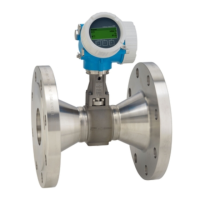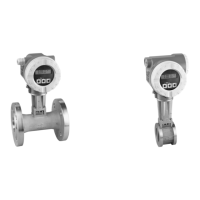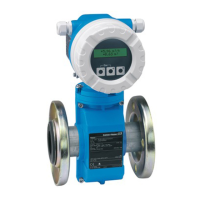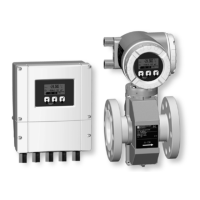Installation Proline Prowirl R 200 HART
26 Endress+Hauser
6.1.2 Requirements from environment and process
Ambient temperature range
Compact version
Measuring device Non-hazardous area: –40 to +80 °C (–40 to +176 °F)
1)
Ex i, Ex nA, Ex ec: –40 to +70 °C (–40 to +158 °F)
1)
Ex d, XP: –40 to +60 °C (–40 to +140 °F)
1)
Ex d, Ex ia: –40 to +60 °C (–40 to +140 °F)
1)
Local display –40 to +70 °C (–40 to +158 °F)
2) 1)
1) Additionally available as order code for "Test, certificate", option JN "Transmitter ambient temperature –
50 °C (–58 °F)".
2) At temperatures < –20 °C (–4 °F), depending on the physical characteristics involved, it may no longer be
possible to read the liquid crystal display.
Remote version
Transmitter Non-hazardous area: –40 to +80 °C (–40 to +176 °F)
1)
Ex i, Ex nA, Ex ec: –40 to +80 °C (–40 to +176 °F)
1)
Ex d: –40 to +60 °C (–40 to +140 °F)
1)
Ex d, Ex ia: –40 to +60 °C (–40 to +140 °F)
1)
Sensor Non-hazardous area: –40 to +85 °C (–40 to +185 °F)
1)
Ex i, Ex nA, Ex ec: –40 to +85 °C (–40 to +185 °F)
1)
Ex d: –40 to +85 °C (–40 to +185 °F)
1)
Ex d, Ex ia: –40 to +85 °C (–40 to +185 °F)
1)
Local display –40 to +70 °C (–40 to +158 °F)
2) 1)
1) Additionally available as order code for "Test, certificate", option JN "Transmitter ambient temperature –
50 °C (–58 °F)".
2) At temperatures < –20 °C (–4 °F), depending on the physical characteristics involved, it may no longer be
possible to read the liquid crystal display.
‣
If operating outdoors:
Avoid direct sunlight, particularly in warm climatic regions.
You can order a weather protection cover from Endress+Hauser. → 169.
Thermal insulation
For optimum temperature measurement and mass calculation, heat transfer at the sensor
must be avoided for some fluids. This can be ensured by installing thermal insulation. A
wide range of materials can be used for the required insulation.
This applies for:
• Compact version
• Remote sensor version
The maximum insulation height permitted is illustrated in the diagram:

